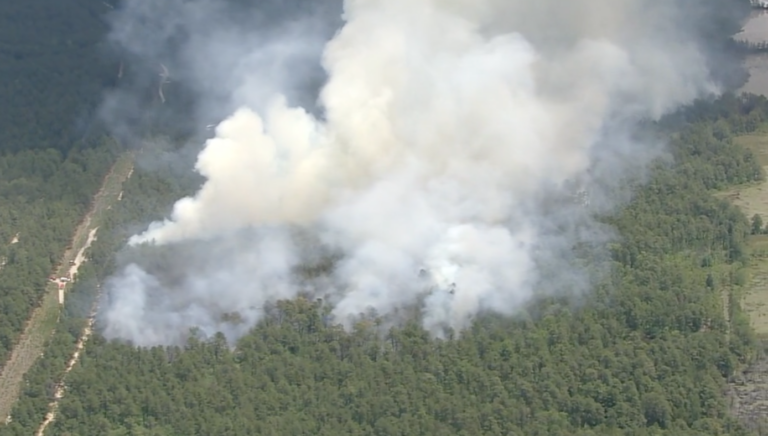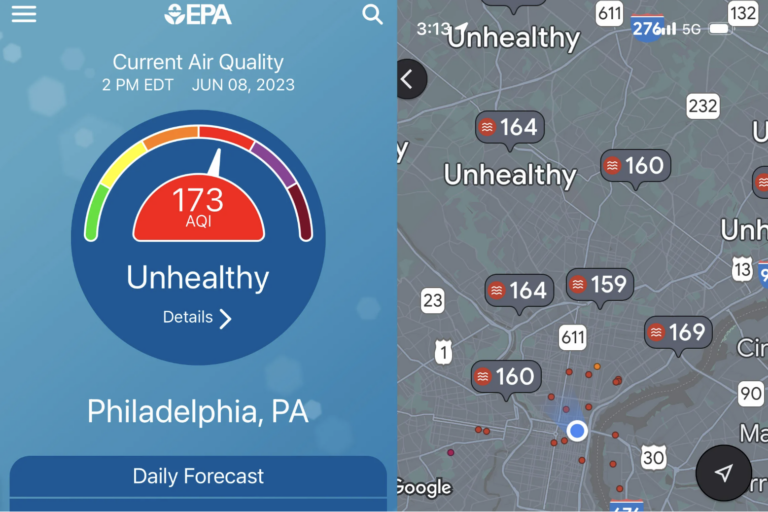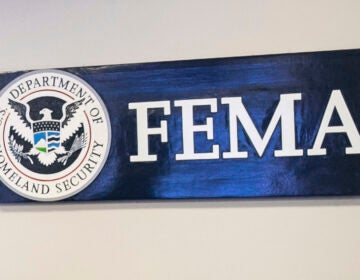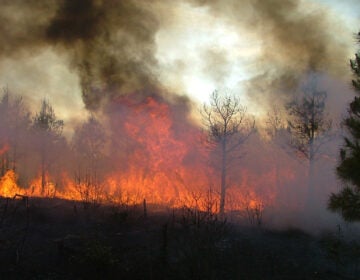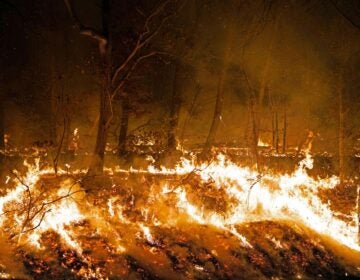Wildfire updates: Smoky conditions improve across the Philly region
Here's what you need to know about the wildfire smoke and air quality situation in Philadelphia, Pennsylvania, New Jersey, and Delaware.
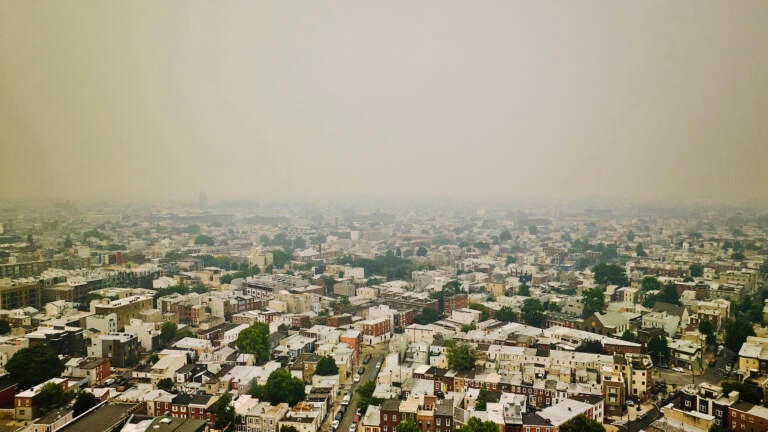
Haze covers Philadelphia on June 8, 2023 due to wildfire smoke. (Michael James Murray)
What you need to know
- The Delaware Valley is seeing cleaner skies after days of lingering wildfire smoke.
- As conditions improve, here’s how to understand your air quality index.
- While we’ve seen the worst of this round of haze, we can expect more massive wildfires this summer thanks to climate change.
Here's the latest
-
Blue skies and cleaner air return to Philadelphia region
Jun. 9, 2023 2:59 pm
-
Drone video captures smoky haze over Philadelphia
Jun. 8, 2023 12:49 pm
-
What is the air quality index? Here’s how to understand your AQI
Jun. 7, 2023 12:29 pm
-
Staying safe in smoky air is particularly important for some people. Here’s how
Jun. 9, 2023 8:13 am
-
How climate change is contributing to the region’s bad air
Jun. 7, 2023 7:33 pm
Smoke from Canadian wildfires began to move south and west of the Philadelphia region on Friday, granting a welcome break from the hazardous and unhealthy air quality of the past several days.
Forecasters say the air quality will continue to improve and residents will be able to enjoy outside activities and exercise once again.
While the state of Pennsylvania issued a Code Orange — meaning vulnerable people should limit their time outdoors — the air monitors in and around Philadelphia, Camden, and Wilmington show moderate levels of pollution.
Some areas of New Jersey are in the green, meaning good air quality. Saturday is expected to bring good or moderate air quality to the area.
“The good news is things are improving,” said Lauren Casey, a meteorologist with Climate Central. “You can see some blue sky. Now we’re down to moderate at most of the recording centers, even down to good air quality in [some areas] in and around Philadelphia and South Jersey.”
Although Canadian wildfires are still burning, Casey said it’s not clear if wildfire smoke will return to the area this summer.
While attribution studies have yet to materialize on these particular wildfires, she said, climate change is generally expected to lead to more, which will mean more bad air quality days overall.
“All of this is being exacerbated by climate change,” Casey said. “So, we’re seeing more frequent, more widespread, and more intense wildfires. And that has an impact on us here in the Delaware Valley, the Greater Philadelphia area, because the upper-level winds can pick up that smoke and drive it into our skies. And that’s exactly what happened over the last several days.”
The Canadian wildfire season got off to an early start. Typically, Casey says, about 2.5 million hectares will burn each year. This season, more than 4 million hectares have already been destroyed.
This story originally appeared on 6abc.
Crews are responding to a wildfire in Burlington County, New Jersey.
The New Jersey Forest Fire Service reported the fire late Friday morning.
It’s burning in the area of City Line Road in Browns Mills.
People are asked to avoid the area.
This comes after two major wildfires recently. Last week, a wildfire in Bass River Township, Burlington County consumed 5,000 acres.
A fire earlier this week in Jackson Township, Ocean County burned 82 acres.
Smoky conditions have improved in the Philly region since midweek, but air quality concerns remain — leading to a bevy of event cancellations.
Saturday’s Disability Pride Parade and Festival will not take place as planned, the PHL Visitor Center announced Friday.
East Passyunk’s Flavors of the Avenue and other festivals are also among this weekend’s canceled events.
This year’s Odunde Festival, the largest African American street festival in the U.S., is still on for this weekend.
Though conditions are expected to improve over the course of the weekend, residents within vulnerable populations — including children, people with heart and lung conditions, and older adults — face heightened health risks when air quality is poor.
Here’s how you or your loved ones can help reduce risk amid air quality concerns.
And here’s how to check air quality conditions in your area (without going outside).
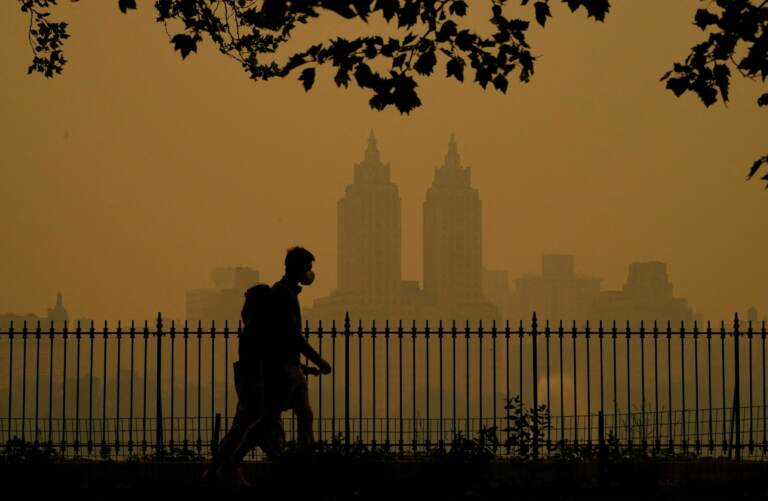
Smoky air is filled with microscopic flakes of particulate matter that can get into the lungs and even into the blood stream. (Timothy A. Clary/AFP via Getty Images)
While a thick yellow haze has blanketed much of the Eastern U.S. this week, some of the poorest air quality in the world has been in New York City. Pulmonologist Dr. Ravi Kalhan, of Northwestern Medicine likened it to New Yorkers smoking a pack of cigarettes a day.
The health hazards of long-term smoking are well understood, but what are the dangers of short-term exposure to wildfire smoke — like the smoke that is still drifting south from Canada’s wildfires?
“I think that everyone has some degree of risk when air pollution levels are to this extent,” says Dr. Keith Brenner a pulmonary and critical care doctor at Hackensack University Medical Center.
But it’s people with preexisting lung conditions like asthma or COPD (chronic obstructive pulmonary disease) who are most at risk.
Smoky skies can cause itchy eyes, sore throats, headaches and even a little nausea. But it’s the fine particles – particulate matter that’s 2.5 microns or less in diameter – that are the biggest health hazard. These particles can get into your lungs, and for people with lung conditions they can trigger a flare up. “Worst case scenario you might even have to be admitted to the hospital,” Brenner says.
» READ MORE: Staying safe in smoky air is particularly important for some people. Here’s how
The Streets Department will resume all of its outdoor operations on Friday, June 9. Crews will be working through Saturday to pick up any delayed trash and recycling collections. (1/3) pic.twitter.com/krDIwzjgLy
— philastreets (@PhilaStreets) June 9, 2023
Air quality alerts remain in effect across the Delaware Valley Friday, though smoky conditions have begun to improve.
A Code Red Air Quality Alert is in effect for Delaware, while a Code Orange Air Quality Alert is in effect for Philadelphia and New Jersey.
Under a Code Red, air pollution concentrations are considered unhealthy for the general population and outdoor activity should be avoided.
Under a Code Orange, air pollution concentrations may be unhealthy for vulnerable groups such as children, people with asthma, people with heart or lung disease, and older adults.
Experts recommend avoiding the outdoors, keeping windows shut, and running air conditioning on a re-circulation setting. Those who go outside are encouraged to wear a high-quality mask, such as an N-95 or KN-95, to reduce pollution exposure.
Overnight, Philadelphia’s air quality index peaked at 427 out of a maximum of 500, WHYY News partner 6abc reported. By Thursday evening, that number was down to 151.
The smoky conditions may improve over the next several days.
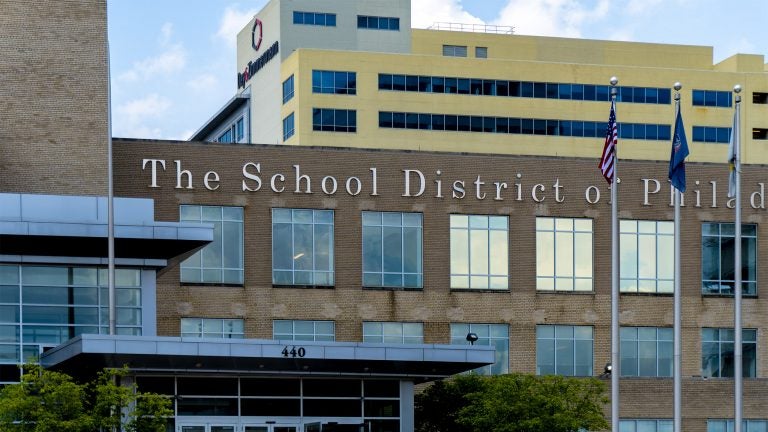
Philadelphia School District headquarters. (Danya Henninger/Billy Penn)
Philadelphia public school students will learn virtually Friday, as hazardous smoke from Canadian wildfires continues to hang over the city.
Teachers, and all other employees, are required to report to work in person, though “air-quality related absences” will be excused, said district Superintendent Tony Watlington in a letter to families.
All students are expected to log on for remote learning, Watlington said. This could prove challenging though, since some schools have already collected computers from students, according to reports from staff. The end of the school year is next Tuesday.
Outdoor activities, including sporting events and field trips, will be canceled for the third day in a row.
Moving-up and graduation ceremonies will still happen, but Watlington said outdoor events will take place at “alternative locations, and in some cases, at adjusted times.”
“If your school was scheduled for an outdoor graduation on June 9, you can expect to hear from your child’s principal today regarding alternative plans,” he said.
Philly public schools were open Thursday, while some nearby suburban districts were closed, including Neshaminy, Bristol, and Pennsbury. Some of the region’s larger suburban districts, including Central Bucks and Lower Merion, remain open.
School District of Philadelphia officials encouraged students to wear masks on their way to and from school Thursday.
Schools were instructed to keep all windows and doors closed to “minimize air pollution,” something that could lead to uncomfortable conditions since most Philly public schools don’t have central air conditioning.
The district enacted new heat protocols last year that instruct officials to monitor conditions when temperatures are projected to reach 85 degrees or higher and to consider closing schools when it hits 90 degrees.
Ninety-one Philly schools closed early due to high temperatures last Friday.
“I think the one saving grace for today is that outdoor temperatures are not climbing above the upper 70s,” Watlington said during a press conference Thursday. He added that additional nurses were at schools today to keep an eye on the health of staff and students.
When asked whether attendance had dipped today due to the hazardous air, Watlington said he didn’t have the numbers on hand and added that any absences today for students or staff would be excused.
Watlington has made attendance a priority during the first year of his tenure but said he’ll let these absences slide.
“We’ll be more understanding of this one,” he said.

Evening commuters travel on Broad Street past a hazy City Hall, Wednesday, June 7, 2023, in Philadelphia. (AP Photo/Matt Slocum)
Millions of Americans from the Northeast to the Midwest were under air quality alerts on Thursday, as smoke from Canadian wildfires continues to fill the skies.
The haze — which contains particulate matter that poses both short- and long-term health risks — has disrupted air travel, sporting events and all sorts of outdoor activities.
Officials are warning people, especially children, the elderly and those with heart and respiratory conditions, to take precautions and stay inside until the smoke clears, which could take days.
“There’s nothing you can do about the processes of the atmosphere,” says William Vizuete, a professor in the department of of environmental sciences and engineering at the University of North Carolina at Chapel Hill. “But we need to understand those processes so we can eventually understand what we’re exposed to when we’re exposed to those [particles].”
Forecasters expect hard-hit areas in New England and the Mid-Atlantic to see some relief on Friday, but shifting wind patterns could mean worsening air quality for people across vast stretches of the Midwest and South.
» READ MORE:
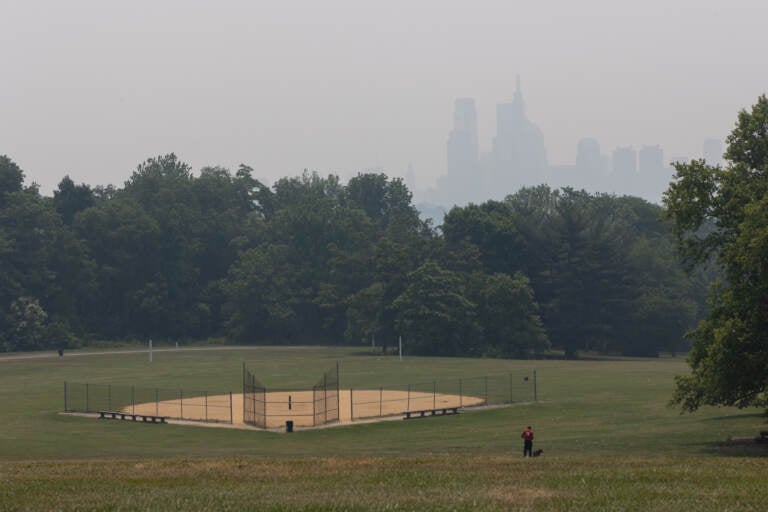
Smoke from wildfires in provinces of Ontario and Quebec in Canada made Philadelphia’s iconic Belmont Plateau skyline nearly invisible on June 7, 2023. (Kimberly Paynter/WHYY)
As smoke from the wildfires in Canada linger across the Northeast some events have been postponed or canceled.
The Point Breeze Night Market has been postponed after “consultation with Philadelphia Health Department officials.”
The Philadelphia Inclusive Growth Coalition and The Chamber of Commerce for Greater Philadelphia postponed an outdoor rally in front of city hall advocating for business tax cuts in the proposed budget due to poor air quality.
The 52nd and Haverford Farmers Market was closed and will return on June 14.
The city of Philadelphia’s pop-up Water Bar event at noon was postponed until next week due to poor air quality.
The Legacy Tennis Center in East Falls, which trains city youth, is closed due to bad air quality and may shut down tomorrow if the situation does not improve.
Outdoor yoga at Lardner’s Point is canceled by the Riverfront North Partnership.
Fishtown Beer Runners canceled its nightly run tomorrow but ‘strongly recommend you get to the bar, no questions asked’ unless there is “some relief from our smoky skies.”
Delaware Thoroughbred Racing Commission has canceled live horse races due to “very unhealthy air quality levels in the race” and is expected to resume on Friday.
The Philadelphia Public School District and The Camden City School District postponed outdoor field trips and canceled recess outside due to poor air quality.
Popular happy hour night known as Center City SIPS where dozens of restaurants and bars attract crowds with food and drink specials is still on this evening.
“CCD SIPS will continue this evening but all participating bars and restaurants, particularly outdoor venues, are encouraged to proceed as they see fit in the best interests of both their business and their customers,” said Givana Suraci spokesperson for Center City District in an email.
The Phillies are scheduled to play the Detroit Tigers at Citizens Bank Park tonight at 6:05 p.m. As of 2 p.m., Phillies spokesperson Bonnie Clark said “there have been no changes” to the baseball team’s game schedule.
Saturday’s Art for the Cash Poor on N. American Street has been rescheduled for the fall.
An end to the smoky haze that’s been covering the Philadelphia region may be in sight, though it could take a few days.
After early Thursday morning brought Phily’s worst air quality index (AQI) readings of the week — AQIs of 350+ and higher, firmly in the “hazardous” range — the haze dissipated somewhat during the day.
But the dense smoke streaming down from wildfires in Canada could return later in the evening, according to the National Weather Service Philadelpha/Mount Holly.
That pattern of high AQI in the morning followed by a midday drop only to rise again at night happens because of the way the heat from the sun affects the air, NWS Mount Holly meteorologist Sarah Johnson told Billy Penn.
“I suspect one of the reasons is during the day we typically see mixing between lower levels of the atmosphere and middle levels of the atmosphere,” Johnson said, which helps with dispersion.
Generally, the main weather pattern responsible for bringing the smoke to the Philadelphia area is static, she said, but is expected to shift west. This isn’t an actual NWS forecast, Johnson said, noting that the EPA is the federal agency that takes the lead in making air quality predictions.
When will we see blue skies again? The NWS haze data comes from a short-term model, per Johnson, so it only looks a day or so in advance.
The state Dept. of Environmental Protection, however, does make longer-term predictions — and things are looking up.
“Over the weekend, expect increasing amounts of sunshine each day,” said Daniel Roble, a Pa. DEP air quality program specialist, in his Thursday morning extended smoke outlook, citing a likely shift in “orientation of the plume of smoke impacting the northeastern U.S.” and potential rain.
In the meantime, AQI will likely ebb and flow, and it can vary quite a bit depending on location. Here are some tools to help you track the air quality in your immediate vicinity.
Philly Health Department air quality tracker
The health department monitors Philly’s air quality daily and in real-time. Philadelphians can click to view a meter tracking the city’s overall AQI number, along with an explanation of the scale that indicates whether or not the reading is safe or hazardous.
Find it here: Phila.gov
Philly Health Department air monitoring stations map
This map lets you look at each of the city’s seven air quality sensors and view the pollution counts in that specific area. There’s no AQI reading; instead It’s more detailed, showing the types of pollutants and the concentrations of each pollutant in that area.
Find it here: Phila.gov
AirNow
This tracker from the EPA, which monitors air quality daily and in real-time, lets you enter your zip code to find the AQI in your area. It shows whether air is hazardous or not, who each reading is hazardous for, as well as recommendations for what to do for each reading.
You can view a color-coded map of AQI around the region, and read a fine-print air quality forecast with information provided by the Pennsylvania Department of Environmental Protection. There is also a free app version of this tool.
Find it here: AirNow.gov | Apple App Store | Google Play
PurpleAir / Google Maps
PurpleAir is a Utah-based company that sells air quality sensors, per its website. It publishes an online map that tracks AQI in real-time based on those sensors, which are all over the region — in more locations than the city’s seven. The site also shows a mini forecast of how the air quality will change throughout the day.
There is no standalone PurpleAir app, but the data is used to power an air quality layer you can turn on if you use the Google Maps app — kind of like viewing how bad traffic is in a given area, but instead with pollution.
Find it here: PurpleAir.com | Apple App Store | Google Play
AQICN
AQICN is part of the World Air Quality Index, a nonprofit project powered by volunteer scientists that was started in 2007 in Beijing, per its website. It provides AQI readings that update every two hours or so, and provides readings on a city or county level. It also displays info on the specific pollutants affecting each area, along with temperature, humidity, wind, and pressure. Below the initial reading, a forecast can be found for the next four days.
Find it here: AQICN.org
Physical air pollution monitors
If you want to get ultralocal and determine the air quality inside your home, you can buy your own air quality sensor. Most work the same as the ones used by the EPA, meaning they can pick up on five pollutants as well as temperature and humidity. They range from around $150 to several hundred dollars.

Evening commuters travel on Broad Street past a hazy City Hall, Wednesday, June 7, 2023, in Philadelphia. (AP Photo/Matt Slocum)
Poor air quality related to wildfires in Canada continues to linger in the Philadelphia region.
Particles in the air are known to cause respiratory and cardiovascular problems. However, neurologists say the particulate matter associated with wildfires may also contribute to increased headaches, and trigger migraine symptoms.
A University of Pennsylvania study published in January 2023 suggests that poor air quality caused by wildfires are likely to increase the odds of getting a headache. The researchers evaluated emergency room visits in California during wildfires.
Lead researcher and neurologist Holly Elser said the association between wildfires and headaches deserves greater medical attention as climate change is expected to reduce air quality in the future — and as wildfires impact other parts of the U.S.
“The climate and the environment are going to have implications for patients with neurologic disorders — whether that’s headache, MS, stroke, dementia — and, we as clinicians need to be ready to care for our patients as the climate changes,” she said.
Elser said she hopes her research will bring more awareness to patients, and she calls for continued research into the health impacts of wildfires.
“We need more national data that speaks to the experiences not only of people who are in the most highly affected areas when there are these big wildfires, but also whether or not there are sort of remote health effects for people who live far away,” she said.
» READ MORE: How wildfires and climate change impact headache and migraine symptoms
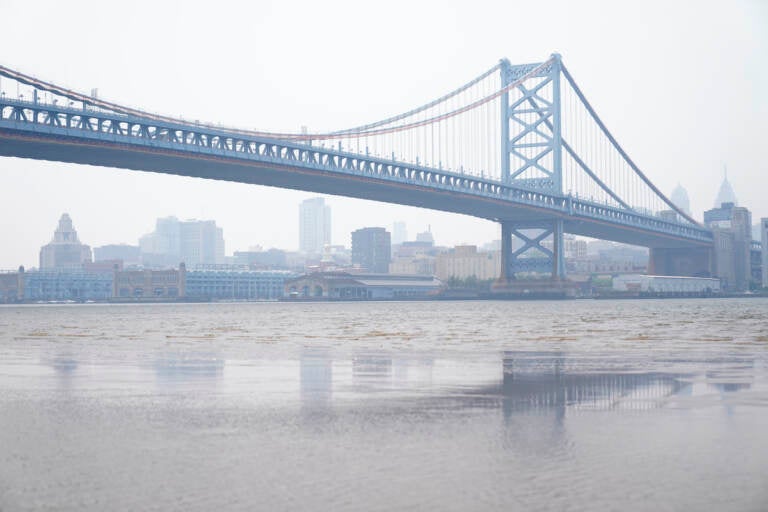
The Benjamin Franklin Bridge and the Philadelphia skyline are shrouded in haze, Wednesday, June 7, 2023. (AP Photo/Matt Rourke)
The Philadelphia Office of Emergency Management is coordinating with the National Weather Service to determine when the smoke from wildfires in Canada could clear up.
Director Dominick Morales said the office has been getting 911 calls since Tuesday due to people smelling smoke, including residents in Montgomery and Delaware counties.
During a news conference at City Hall on Thursday, Morales said they won’t have a “concrete prediction” as to when conditions could clear for at least the next 24 hours.
“This is almost like a snowstorm for us,” he said. “We have a bit of a prediction. We understand how bad it could be, but the timing varies and I think anybody who’s been in the city for any period of time has heard us be really concerned about snowstorms that never materialized and similarly has heard us, quite frankly, all turn around and go, ‘Oh wow, it snowed a lot more than the forecasters had called for.’”
Philly OEM said it’s working with the NWS in Mount Holly to discuss the latest weather patterns to get a better idea of when things could improve.
Health officials encourage people stay indoors, but if you need to be outside, it’s recommended you wear an N-95 or KN-95 mask.

A person wearing a protective face mask walks past the skyline in Philadelphia shrouded in haze, Thursday, June 8, 2023. (AP Photo/Matt Rourke)
All non-essential city workers doing outside work have been brought inside as a result of the poor air quality. That includes sanitation workers, those doing street paving, street cleaning, and recycling duties.
During a briefing Thursday afternoon, Mayor Jim Kenney said those who can do inside work will be assigned to do so, others will be sent home.
Health Commissioner Dr. Cheryl Bettigole said the particulate count went up to 500 at one point last night, the highest measure of the pollutant ever.
City officials are watching the weather forecast and trying to figure out their next move with hopes the smoke will lessen over the next few days.
Even reduced levels of fine particulate pollution can cause negative health effects, especially for people with lung or heart conditions, young children, older adults, and pregnant people.
Bettigole urged all in those groups to stay indoors until the threat passes.

Experts say harmful particles can seep into indoor spaces. (Ed Jones/AFP Via Getty Images)
This dispatch originally appeared on NPR.
It’s not just the outdoors that can be unhealthy during an influx of smoke. The EPA says all those fine particles you breathe in while outdoors can also sneak inside, through open windows and doors, small cracks and pores, and mechanical ventilation, such as the bathroom fan.
Sam Brasch, a reporter with NPR member station CPR News, spoke to an expert on how to prepare your home for these smoky days. Alex Huffman, a professor studying air contaminants at the University of Denver, offers these four tips:
- Monitor the indoor air quality of your home to know when your air is unsafe.
- Buy (or make) a high-quality indoor air filter.
- Seal up openings and run your air conditioner (if you have one).
- Support long-term community solutions, like overhauling outdated building codes.
Courtney Flatt of NPR member station KUOW spoke to another expert on what to do when the skies fill up with smoke. Chrissi Antonopoulos, an analyst with the Pacific Northwest National Laboratory, offered these tips:
- Make a space at home that’s kept as smoke-free as possible, known as a clean room.
- Keep the door shut as much as possible.
- Avoid running window air conditioners as much as possible, and turn off ventilation, like in bathrooms, that pulls air inside.
- Avoid creating other indoor air pollution, such as cooking with a gas stove or burning incense or candles.
- Seal up attics, foundations and windows for the long term with the help of professionals.
➡️ Read more on how to protect your home from smoke from CPR News and KUOW.
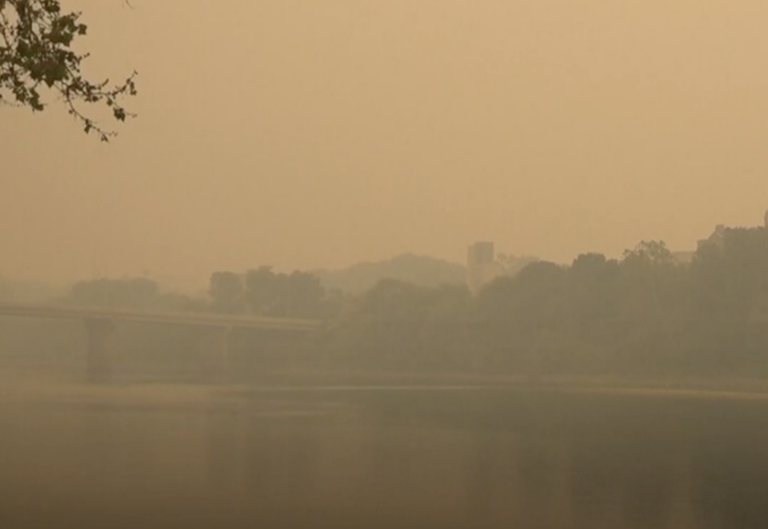
Thee smoky blanket is billowing across the U.S. and Canada from wildfires in Quebec and Nova Scotia. (AP Photo)
Dangerous levels of air pollution continue to blanket the Philadelphia region — exceeding Code Red and Code Purple in many areas and reaching into the hazardous Code Maroon.
Delaware’s New Castle County reached hazardous levels Thursday morning. Officials there are recommending people stay indoors.
Lauren Casey, a meteorologist with Climate Central, says when air quality is as bad as maroon — it means everyone is impacted.
“So when we’re at this maroon level, that really means you should spend as little time outdoors as you possibly can.”
Casey says the different levels of bad air can vary within the much larger region.
Health officials advise wearing a good mask, either an N-95 or KN-95, if you do have to be outdoors. Outdoor exercise is not recommended.
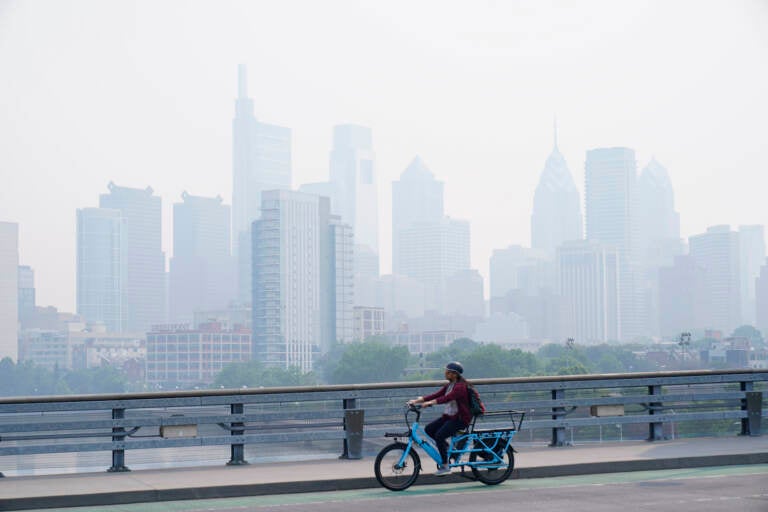
A person cycles past the skyline in Philadelphia shrouded in haze, Thursday, June 8, 2023. (AP Photo/Matt Rourke)
Philadelphia’s Streets Department has paused all outdoor operations scheduled for Thursday afternoon due to poor air quality fueled by wildfires in Canada.
“Due to the unhealthy air quality, all Streets Department outdoor operations will be suspended at noon today,” the department’s statement read. “This includes trash and recycling collections, mechanical cleaning, paving, traffic, street lighting and street repairs.”
“This is being done out of an abundance of caution for employees sensitive to the air pollution.”
“Residents should leave their trash and recycling at the regular pick up locations if their materials have not been collected. The Streets Department will provide additional updates later as the situation continues.”
Updates can be tracked on the department’s Twitter account.
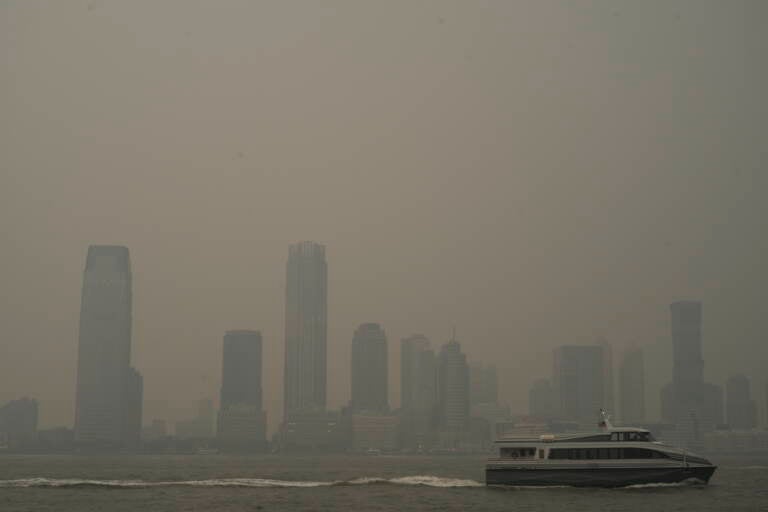
Buildings in Jersey City, N.J. are partially obscured by smoke from Canadian wildfires as a ferry travels up the Hudson River, seen from the Manhattan borough of New York on Tuesday, June 6, 2023. (AP Photo/Patrick Sison)
New Jersey Gov. Phil Murphy announced that N95 masks would be available upon request at six NJ Transit stations. The stations are Atlantic City, Camden, Newark Penn Station, Trenton, Secaucus, and Hoboken.
Officials across the region have recommended those who do have to travel to wear an N95 or KN95 mask to block out harmful particles within the smoke coming from Canadian wildfires.
An air quality alert issued by the state Department of Environmental Protection was extended to Friday.
⚠️The previously issued Air Quality Action Day for Thursday, June 8th is being upgraded to the Unhealthy category statewide. In addition, this alert has been extended to Friday, June 9th at 11:59 pm. pic.twitter.com/jUD4098mgU
— New Jersey Department of Environmental Protection (@NewJerseyDEP) June 8, 2023
State Health Commissioner Judy Persichilli said 143 people sought care for asthma-related problems Wednesday, which is the highest number on average in the last two months.
She advised those with respiratory issues like asthma and chronic bronchitis to stay indoors, especially children.
“If your child has asthma, it is important to make sure that all their medications, including their daily preventative medicines and rescue inhalers, are available and close by,” she said.
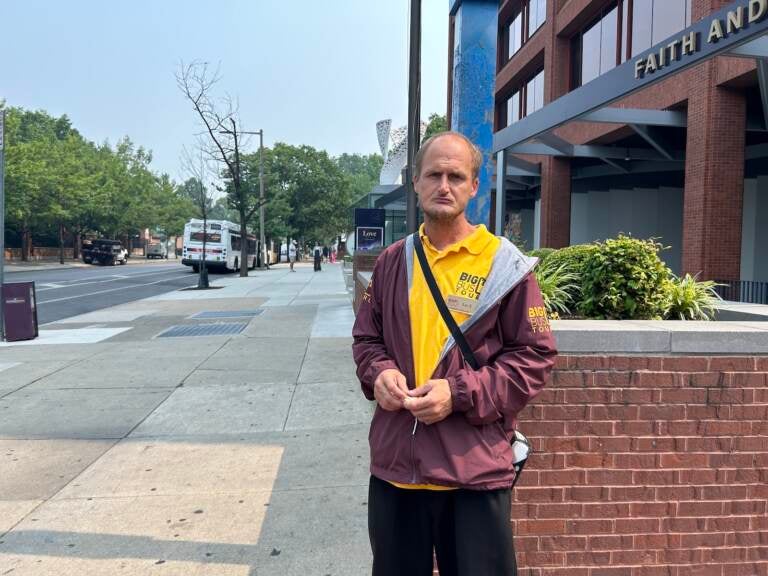
Lee Tilley, a resident of Northeast Philly, was selling tickets for a tourism company near the Liberty Bell outside Thursday. (Sophia Schmidt/WHYY)
Despite poor air quality and warnings to stay indoors, some Philadelphians and visitors braved the smoky air in and around Center City Thursday morning. The Canadian wildfires continue to blanket the city with smoke, leading to historic levels of pollution. But most agreed Wednesday felt worse than today.
“Yesterday it was bad,” said Lee Tilley, a resident of Northeast Philly who was selling tickets for a tourism company near the Liberty Bell. “Today’s a little better than yesterday, but it’s still here.”
Philadelphia’s air was “very unhealthy” Thursday morning, according to the EPA’s Air Quality Index. By early afternoon, the index had dipped into the “unhealthy” for everyone range.
Tilley works outside, and said he’s feeling the effects.
“It’s definitely weighing on my breathing a bit,” he said. “But I just stay calm. I’ve got to work.”
Tilley’s daughter, who has asthma, has been coughing, he said. The family is keeping their windows closed at home and running air conditioning.
Experts recommend using air conditioning on the recirculate function, rather than pulling in unhealthy air from outside.
“Her mother’s been keeping her home from school, keeping her in the house,” Tilley said.
Skipper Johnson, a bus driver, stood outside while taking a break.
“It was pretty bad yesterday,” Johnson said. “My eyes were watering, but I was able to deal with it, because one of the things as operators is we’ve got to persevere through a lot of stuff. … Hopefully tomorrow will be even better than it is today.”
Todd Goldison, a resident of Wynnefield, wore a fabric mask while waiting near a bus stop in Center City. Goldison said he smelled a “burning odor” in the air Wednesday.
“It’s a shock,” Goldison said. “It’s something new to all of us.”
Lori Konat, who was visiting Philly from Lancaster, said she was coughing and her eyes were hurting Wednesday.
“It had me concerned more than ever — I’m already concerned — about climate change and how it affects all of us,” she said. “Maybe this is a harbinger of things to come.”
Meteorologists and climate scientists say climate change is contributing to increased wildfires and fire weather conditions in the U.S. and Canada.
As Philadelphia and the surrounding region continue to grapple with poor air quality, health experts recommend avoiding the outdoors. Those who do go outside are urged to wear a high-quality face mask.
If residents need access to KN-95 masks, the Philadelphia Department of Public Health’s resource hubs are providing them free of charge.
Also at city resource hubs are over-the-counter COVID-19 test kits, condoms and other sexual wellness materials, pack n’ play cribs for new or expecting parents, and air purifiers and filters for early childhood education centers.
A list of resource hub locations can be found below. No appointments are necessary to visit.
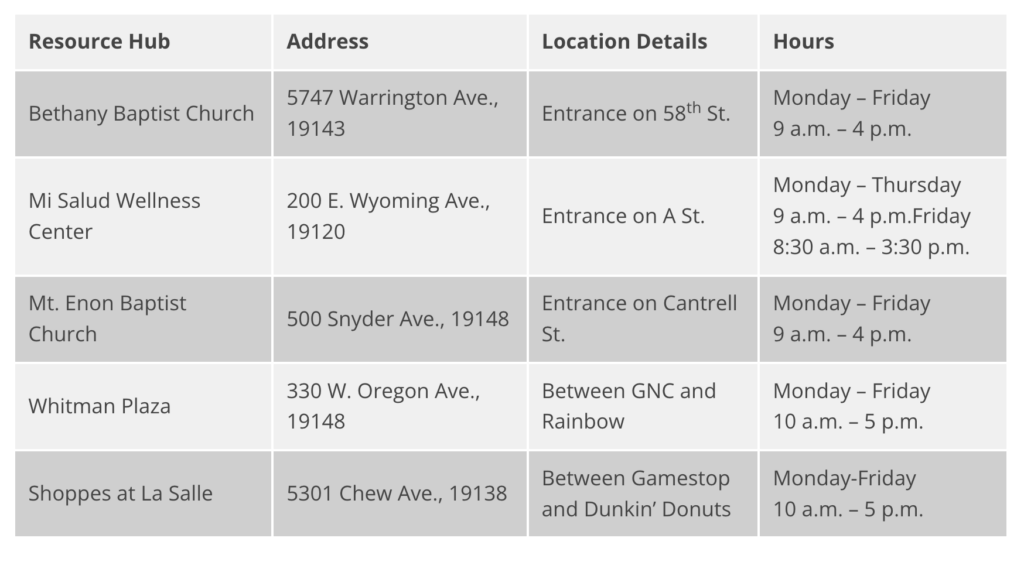
Residents can check air quality conditions in their area (without going outside) by using AirNow, an interactive map that breaks down air quality conditions and warnings.
» READ MORE: Can masks and purifiers protect you from bad air? Here’s what the experts say
The ground stop impacting inbound flights to #PHLAirport has been lifted, however, passengers should check with their airlines for the latest flight information. pic.twitter.com/qMq3V37eHF
— PHLAirport (@PHLAirport) June 8, 2023
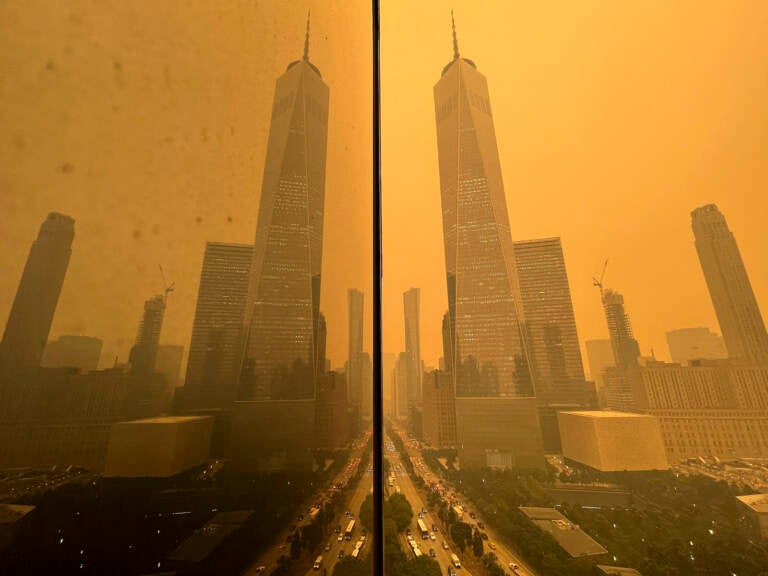
Traffic moves along West Street past One World Trade Center, in this mirror image reflected in the facade of a building, Wednesday, June 7, 2023, in New York, amidst smokey haze from wildfires in Canada. Smoke from Canadian wildfires poured into the U.S. East Coast and Midwest on Wednesday, covering the capitals of both nations in an unhealthy haze, holding up flights at major airports and prompting people to fish out pandemic-era face masks. (AP Photo/Andy Bao)
On air quality maps, purple signifies the worst of it. In reality, it’s a thick, hazardous haze that’s disrupting daily life for millions of people across the U.S. and Canada, blotting out skylines and turning skies orange.
And with weather systems expected to hardly budge, the smoky blanket billowing from wildfires in Quebec and Nova Scotia and sending plumes of fine particulate matter as far away as North Carolina should persist into Thursday and possibly the weekend.
That means at least another day, or more, of a dystopian-style detour that’s chased players from ballfields, actors from Broadway stages, delayed thousands of flights and sparked a resurgence in mask wearing and remote work — all while raising concerns about the health effects of prolonged exposure to such bad air.
The weather system that’s driving the great Canadian-American smoke out — a low-pressure system over Maine and Nova Scotia — “will probably be hanging around at least for the next few days,” U.S. National Weather Service meteorologist Bryan Ramsey said.
“Conditions are likely to remain unhealthy, at least until the wind direction changes or the fires get put out,” Ramsey said. “Since the fires are raging — they’re really large — they’re probably going to continue for weeks. But it’s really just going be all about the wind shift.”
» MORE: Smoky haze blanketing U.S., Canada could last for days as wildfires rage, winds won’t budge
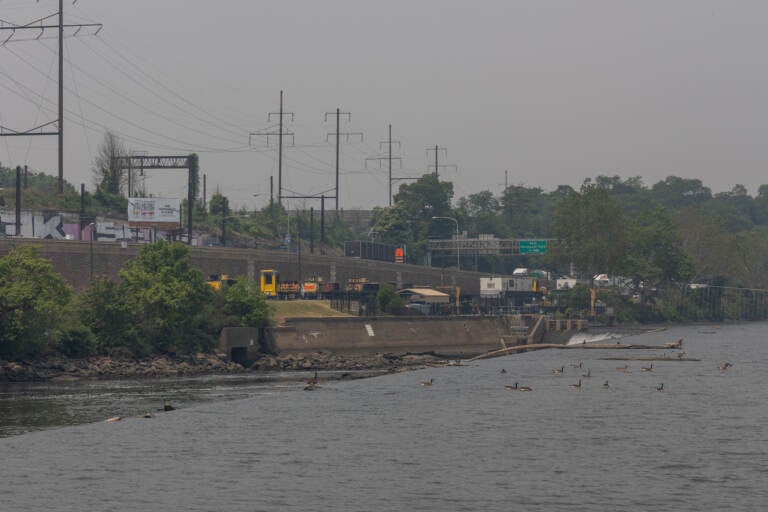
Smoke drifting into Philadelphia from Canadian wildfires prompted code red air alerts on June 7, 2023. (Kimberly Paynter/WHYY)
Wildfire smoke from Western Quebec that thickened the skies around Philadelphia, South Jersey, and Delaware Wednesday afternoon could become more common due to climate change, according to climate scientists. The unprecedented air pollution caused schools to cancel outdoor recess and sports, forced the Phillies to postpone their game with the Detroit Tigers, and prompted emergency messages about decreased visibility on the roads.
Anthony Broccoli, professor of atmospheric science at Rutgers University, said weather patterns pushed the smoke south and near to the ground.
“It’s certainly not unprecedented for wildfire smoke to move across the Northeastern United States,” said Broccoli. “What’s unusual in this case is the smoke is coming from a source that’s closer by and it’s producing poor air quality at the surface.”
Broccoli said the smoke won’t clear until the wind shifts, which he expects to happen Thursday evening or Friday.
Residents are advised not to exercise outdoors and to keep pets indoors if possible.
The Pennsylvania Department of Environmental Protection issued a code red for the entire state but said air quality in some regions could worsen into the rarely used code purple, or even code maroon.
“These aren’t new colors,” said Lauren Casey, a meteorologist with Climate Central. “They’re just so incredibly rare, especially in our area, that you don’t even know they exist. Purple means very unhealthy. So the health impacts could pertain to anyone, not just people with chronic illnesses.”
Casey said maroon is even worse, and is considered hazardous — meaning people should spend as little time outside as possible.
Climate change is contributing to increased wildfires across the western U.S. and Canada, Casey said.
“And then we’re seeing the residual effects because wildfire smoke can travel on the jet stream even from western Canada, thousands of miles away from us into the Delaware Valley, into the Philadelphia region, and affect our air quality.”
Climate change is increasing fire weather conditions, including in New Jersey.
“So we’re seeing these fire weather days happening more often, not only in the west, but in the east as well. So we get the hot conditions, the very low humidity, the dry ground and gusty winds,” Casey said.
Casey said depending on the winds, the air quality can vary from place to place within our region.
The winds are expected to shift, granting relief from the smoke by the weekend.

Mike Kingsley, code blue shelter manager for the Norristown Hospitality Center, is hanging informational flyers as the center closes. (Emily Rizzo/WHYY)
Montgomery County has opened an emergency shelter in Norristown for people experiencing homelessness due to the unsafe air quality.
Most residents are able to avoid the acrid smell of smoke and get out of the thickening air in Montgomery County. But for people experiencing homelessness who want to stay inside and safe from the conditions across the county, options are generally scarce.
Roughly 160 people sleep outside in Norristown, according to Access Services, and about 450 are experiencing homelessness in the entire county.
The Pennsylvania Department of Environmental Protection declared a Code Red for the commonwealth, and state officials urge residents to limit outdoor activities.
But Montgomery County no longer has a permanent overnight shelter for single adults — so after daytime havens like libraries, community centers, and malls close, some people experiencing homelessness will be left outside.
The county announced at 7:18 p.m. Wednesday evening it would open one emergency shelter at St. John’s Episcopal Church at 23 E. Airy Street in Norristown. County spokesperson Kirk Dorn said the shelter has 40 beds.
“We will continue to monitor air quality conditions and determine how long we will keep the emergency action in place,” officials said.
Your Way Home, which partners with the county, sent a newsblast about the air conditions to local organizations that serve people experiencing homelessness.
It’s up to Access Services’ street outreach teams, another partnership with the county, and other community centers like the Norristown Hospitality Center — where unhoused people can stay inside during the day — to disperse masks and to directly inform people of the conditions and indoor options.
“I think word of mouth is going to work best in this situation,” said Sunanda Charles, director of the Norristown Hospitality Center.
As the center closed at 3 p.m. on Wednesday, staff handed out face masks as people were leaving.
“There should have been [an emergency shelter] a year ago,” Charles said. She pointed to the Norristown Public Library as another option for those who want to stay inside, but it closes at 8 p.m.
“Depending on what happens I will consider staying open longer,” she said, before the county’s announcement came.
Kayleigh Silver, administrator of Your Way Home, says Access Services’ outreach team spent today providing water, masks, checking in on people, and referring people to any safe indoor spaces.
Silver said the organization is also encouraging Access Services, which operates 24/7, to use its county funding to purchase emergency hotel rooms for anyone who is “medically compromised particularly due to this situation.”
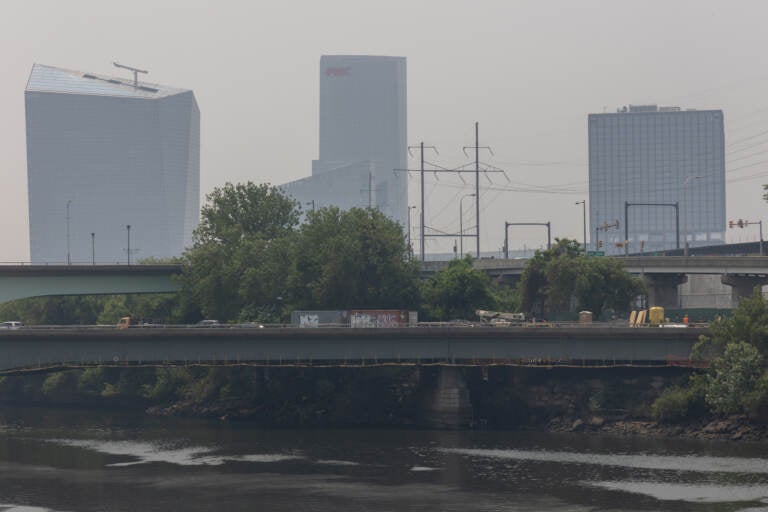
Smoke drifting into Philadelphia from Canadian wildfires prompted code red air alerts on June 7, 2023. (Kimberly Paynter/WHYY)
Some doctors in the Philadelphia region are seeing patients experience respiratory issues, as wildfire smoke brings unhealthy pollution to the East Coast.
“It was just obvious that this will be affecting our patients,” said Dr. Eric Sztejman, a pulmonologist and vice president of clinical operations at Virtua Health in South Jersey.
Sztejman said Virtua’s offices began receiving calls from patients this weekend, then Tuesday and Wednesday, he saw a few more patients than usual with respiratory complaints.
Sztejman characterizes the uptick in patient calls and visits as “minimal.” But he said patients with asthma and chronic obstructive pulmonary disease who spent time outside reported trouble breathing and chest tightness that were not typical of their usual flares.
“One patient was outside walking her dog early this morning,” he said. “She didn’t have a rescue inhaler and by the time she got home, she needed to come over and see us in the office.”
Dr. Olajumoke Fadugba, chief of allergy and immunology at Penn Medicine, said she has received an increased number of calls and messages from patients complaining of asthma flares this week.
“I do think that the impact of the wildfire smoke is affecting our patients,” she said. “There hasn’t been a massive explosion quite yet, and hopefully it will not get there.”
As of late Wednesday morning, the Children’s Hospital of Philadelphia had not seen a rise in patients coming to the emergency department or calling with respiratory problems, said Dr. Tyra Bryant-Stephens, pediatrician and chief health equity officer at Children’s Hospital of Philadelphia and director of the hospital’s Community Asthma Prevention Program.
“We are in the spring, so we tend to see more asthma in the spring anyway,” Bryant-Stephens said.
In Delaware, ChristianaCare’s emergency departments also did not see an increase in patients with issues related to poor air quality Wednesday, said Dr. Justin Stowens, associate program director for ChristianaCare’s Department of Emergency Medicine.
“However, as temperatures change overnight and the wildfires remain active, we urge people to remain indoors and to seek medical care if they experience any symptoms such as difficulty breathing,” Stowens said. “It is especially important for people with health conditions such as asthma, emphysema, COPD, or reactive airway diseases to take extra care and stay indoors.”
Respiratory symptoms from smoke exposure can be delayed, Bryant-Stephens said. They can also last a couple of days for people with underlying conditions, Fadugba said.
“There is what we call a ‘late phase response’ that may not peak until later that day or the next day or even two days later,” Fadugba said.
Sztejman said Virtua’s health system has not seen anything “too crazy” from the poor air quality yet.
“Let’s see what tomorrow brings,” he said.

The Benjamin Franklin Bridge and the Philadelphia skyline are shrouded in haze, Wednesday, June 7, 2023. (AP Photo/Matt Rourke)
A dangerous smoky haze has filled the Philadelphia region due to wildfires burning in Canada.
A code red air quality alert remains in effect for the entire Delaware Valley Wednesday.
Visible satellite shows some of the thickest smoke we have seen moving through our region. It has reached areas from Philadelphia on north and continues to press southward.
While many areas have been in the red unhealthy zone, some places in this plume are showing up in the purple very unhealthy zone now.
Why are we smelling the smoke?
The reason we are seeing such concentrated smoke has everything to do with the weather.
We are stuck in between low pressure out east of Maine with high pressure out west of us. That means wildfire smoke is being directly funneled through the northeast and into our region.
» READ MORE: Why is smoke from Canada impacting the Philadelphia region and when will it go away?

The Ben Franklin Bridge connecting Philadelphia, Pa., to Camden, N.J., in a haze of smoke from Canadian wildfires on June 7, 2023. (Kimberly Paynter/WHYY)
The Pennsylvania Department of Environmental Protection has declared a Code Red Air Quality Action Day throughout the entire commonwealth for fine particulate matter.
State officials are urging residents to limit outdoor activities, particularly among vulnerable populations.
Areas farther east in the state are experiencing worse air quality, the DEP said, possibly within Code Purple ranges.
For areas under a Code Purple, residents should limit outdoor exertion, and vulnerable populations — such as older adults, young children, and people who are immunocompromised — should avoid all outdoor exertion Pets should also be kept indoors.
Residents can check air quality conditions in their area (without going outside) by using AirNow, an interactive map that breaks down air quality conditions and warnings.
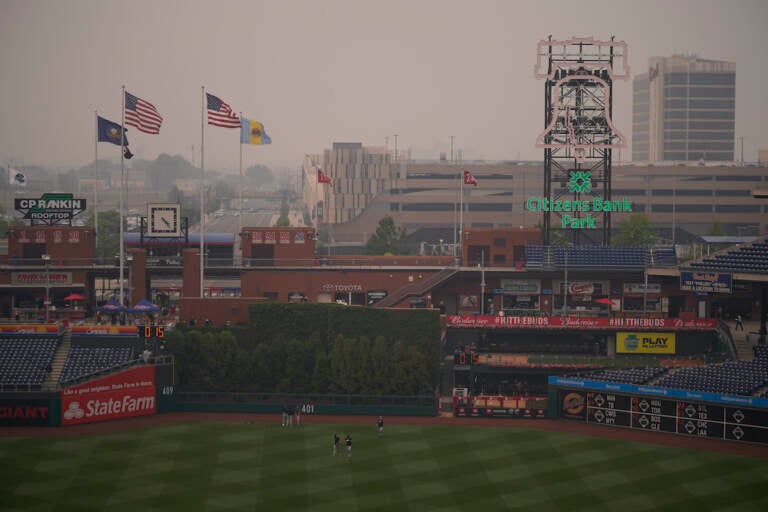
Detroit Tigers' players walk through the outfield at Citizens Bank Park after poor air quality postponed their baseball game against the Philadelphia Phillies, Wednesday, June 7, 2023, in Philadelphia. (AP Photo/Matt Slocum)
The Philadelphia Phillies’ series finale against the Detroit Tigers on Wednesday night was postponed due to poor air quality caused by smoke from Canadian wildfires.
The game was rescheduled for 6:05 p.m. on Thursday, originally an off day for both teams.
Tonight’s game between the Phillies and the Detroit Tigers has been rescheduled due to the air quality in the Philadelphia area. The game will be made up on Thursday, June 8, at 6:05 p.m. pic.twitter.com/VIBDrYcBHD
— Philadelphia Phillies (@Phillies) June 7, 2023
Philadelphia won 1-0 Tuesday in haze and with the smell of smoke in the air. Phillies players and manager Rob Thomson said the conditions did not affect them, though a strong wind blowing in from center field halted three would-be home runs short of the fence.
About a half-hour before the postponement was announced by Major League Baseball, Thomson said he thought Wednesday night’s game would be played. The Philadelphia skyline could not be seen from the ballpark due to haze and a smoky smell remained.
The defending NL champion Phillies (29-32) have won four in a row after losing five straight. Ace right-hander Zack Wheeler (4-4, 4.33) was scheduled to start Wednesday’s contest against Tigers rookie RHP Reese Olson (0-1, 3.60).
Detroit has lost all five games on its current six-game trip and seven of eight overall. The Tigers are 12-20 on the road. Philadelphia is 16-10 at home.
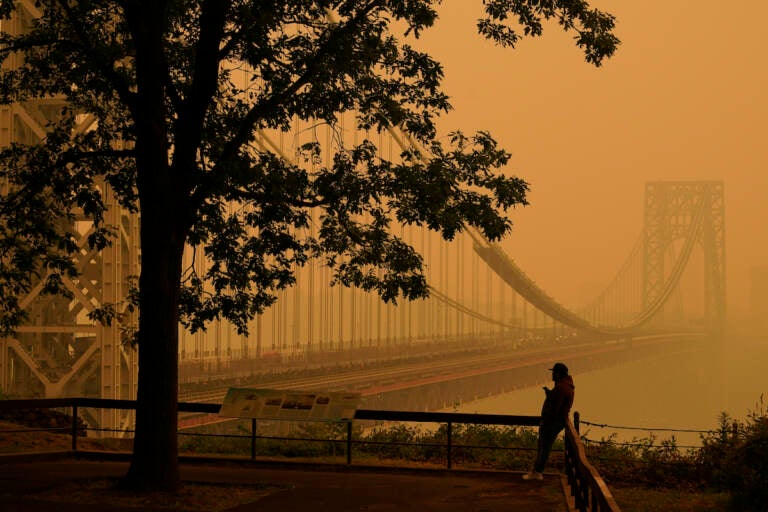
A man talks on his phone as he looks through the haze at the George Washington Bridge in Fort Lee, N.J., Wednesday, June 7, 2023. (AP Photo/Seth Wenig)
New Jersey Gov. Phil Murphy announced that state offices would close at 3:30 p.m. Wednesday due to worsening air quality conditions.
UPDATE: State offices are CLOSING today at 3:30 p.m. due to worsening air quality conditions.
Follow @NewJerseyDEP, @NJDeptofHealth, and @ReadyNJ to stay updated and informed.
☁️ To track air quality in your area, visit https://t.co/DF4Gx79lfJ pic.twitter.com/4mPyfznbGk
— Governor Phil Murphy (@GovMurphy) June 7, 2023
Earlier in the day, Murphy urged residents to reduce their time outdoors.
The state Department of Environmental Protection has extended its air quality alert for the entire state through the end of Thursday.
⚠The previously issued Air Quality Action Day for Wednesday, June 7th is being upgraded to the Unhealthy category statewide. In addition, this alert has been extended to Thursday, June 8th at 11:59 pm.
More: https://t.co/mzTwFbWglE@ShawnLatur pic.twitter.com/uiRJU9WUC3
— New Jersey Department of Environmental Protection (@NewJerseyDEP) June 7, 2023
The alert was originally issued for Tuesday and Wednesday.
The FAA is now slowing traffic from the East Coast and Midwest bound for Philadelphia International Airport due to reduced visibility from wildfire smoke. #AirQualityAlert
— The FAA ✈️ (@FAANews) June 7, 2023
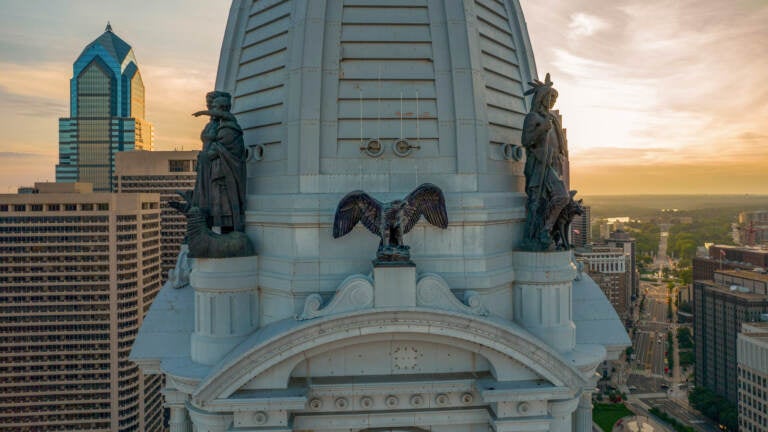
A closeup of Philadelphia City Hall. (Mark Henninger/Imagic Digital)
Philadelphia is under a Code Red Fine Particles Action Day Alert, city officials announced Wednesday morning.
Residents are urged to avoid the outdoors and consider canceling outdoor gatherings. If residents must be outside, they are urged to wear a high-quality mask, like an N-95 or KN-95 mask.
Residents are also asked to help reduce the amount of pollution in the city by avoiding unnecessary car trips, idling, and using gas-powered lawn and garden equipment.
Philly health officials: ‘Avoid going outdoors’ and try not to drive, because of wildfire smoke https://t.co/J6ausuRX7d pic.twitter.com/XAFW1AQuTD
— Billy Penn (@billy_penn) June 7, 2023
Homeless outreach teams are distributing masks to people on the street, according to the Philadelphia Office of Homeless Services. Teams are also encouraging people to stay inside city-funded shelters, which are open.
Indoors, residents are encouraged to recirculate the air in their homes with fans to avoid bringing in more pollution.
“Pay attention to [your] bodies,” health officials said. “If they are having trouble breathing, feeling nauseous, or dizzy, they should seek medical attention as soon as possible.”
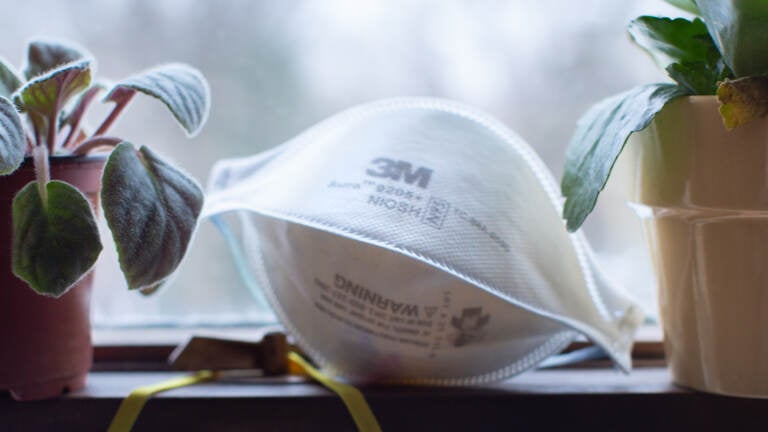
Public health officials say wearing N95 masks outdoors can help reduce intake of air pollution from wildfire smoke. (Jennifer Swanson/NPR)
Another air quality alert has been issued across the region as wildfires in Canada continue to burn, and smoke travels to the northeastern United States. In Philadelphia today, the city’s skyscrapers were drowned by a hazy sky, and a burning smell lingered in the air.
Fine particles in the air can affect vulnerable populations such as children, seniors and people with respiratory and cardiovascular problems. People are advised to avoid outdoor activities.
Wearing the right type of mask could help, said Dr. Jane Clougherty, a professor of environmental and occupational health at the Dornsife School of Public Health at Drexel University.
“Just like we learned during the midst of the COVID pandemic, N95 masks will help filter out the vast majority of fine particulate matter,” she said. “Face masks, unfortunately, will not help to remove gasses from the air, but they can help to reduce individual particle exposures.”
She said KN95 masks would also be effective.
Dr. Khalil Savary, a pediatric pulmonologist at Rutgers New Jersey Medical School, adds that N95 masks must be well-fitted in order to be effective.
He advises people to avoid any outdoor activities, including dining outside, and to close the windows.
“If you have a window unit or a central air unit that’s inside the house and you can recirculate the air inside, that’s good,” Savary said. “Even if you’re in the car, you should turn on [the] recirculate [button] on your car, instead of having the windows open.”
Exhaust fans for dryers and air conditioners with outtake valves might collect outdoor air, and should be closed, he said. Lighting incense, spraying aerosol products, and using gas, wood, propane stoves or furnaces, may also worsen the air quality inside the house. Cleaning with a vacuum that doesn’t have a HEPA filter could also contribute to bad air quality, Savary said.
Air conditioning filters can also remove particles and reduce the impacts of poor air quality, Clougherty said. The flipside, she said, is that air conditioning produces more emissions.
“Air conditioning is very electricity intensive, which does mean we’re increasing the demand on the electricity grid and emissions from power plants upwind of us,” Clougherty said.
Purchasing an air purifier could help, but it must be a HEPA filter, experts say. Other types of systems can contribute to ozone concentrations indoors, which is a gaseous exposure that can irritate the respiratory system. The Environmental Protection Agency has information about air purifiers.
Savary cautions against running to the store, however.
“It’s kind of like the toilet paper debacle of 2020. If you don’t already have a HEPA filter, you can still reduce your exposure by closing the windows, circulating the air in your home,” he said.
Savary advises his patients to make what he calls a “brick city air purifier.”
“You get a 20 by 20 box fan, and you get a nice air filter from a home hardware store, and you pop it on the back and duct tape it, and then you’ve got yourself a filter,” he said.
Those who already have breathing problems are especially at risk for harm from the smoky air blanketing the Philadelphia region this week.
The city’s Code Red Fine Particles Action Day Alert means that the air is unhealthy to breathe and may cause some residents to experience negative health effects.
“We’re asking people to try to minimize the amount of time they spend outdoors and avoid any kind of vigorous activity outdoors,” said Philadelphia Health Commissioner Cheryle Bettigole. “If people do have to go outside, we’re recommending that they wear a high-quality mask, if that’s possible for them. And then inside, we’re asking that people close their windows and doors to minimize the entrance of this fine particle pollution into their homes or offices.”
Bettigole said some people are more vulnerable than others. “This is especially important for people who have heart or lung conditions for children and for people who are elderly, for people who are pregnant,” Bettigole said. “We’re also asking people to try to avoid adding to the fine particulate pollution. So avoid driving, if that’s possible, avoid idling cars, carpool if you can.”
With the fires still burning in Canada, Bettigole said it’s hard to predict when the problem will go away.
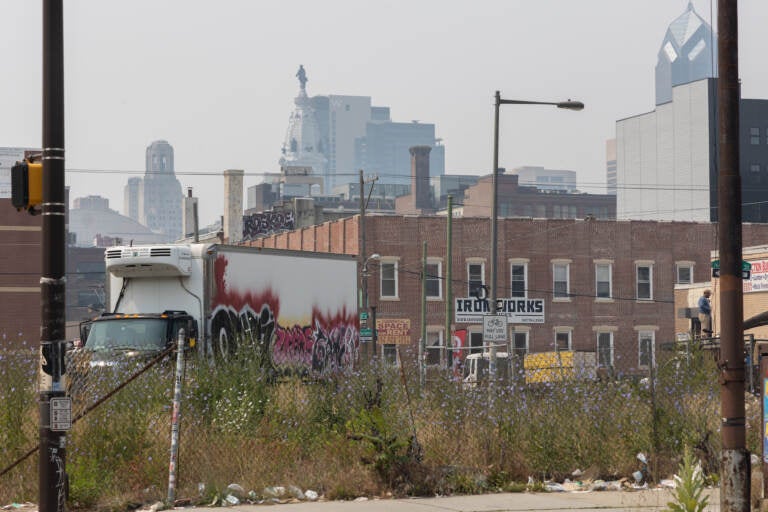
File photo: Visibility in downtown Philadelphia was greatly reduced by smoke drifting into the city from Canadian wildfires on June 7, 2023. (Kimberly Paynter/WHYY)
Wildfire smoke contains small particles that can get into the airways and deep into the lungs, causing irritation and inflammation. The particles, a fraction of the width of a human hair, can even exacerbate heart problems.
“Perhaps your airway gets constricted, narrowed, or gets inflamed,” said Dr. Olajumoke Fadugba, chief of allergy and immunology at Penn Medicine. “Somebody may experience wheezing, shortness of breath, chest heaviness or tightness or coughing. Those are signs and symptoms that there’s something going on.”
Exposure to wildfire smoke over a short period of time, such as a few days, can exacerbate asthma and increase risk of heart attack, according to the EPA.
People most at risk for health effects from the smoke are young children, elderly people, pregnant people, and anyone with pre-existing respiratory conditions such as asthma, or obstructive lung disease.
» READ MORE: How wildfire smoke affects your health, and how to protect yourself
Camden County issued a Code Red Fine Particles Action Day Alert on Wednesday.
The alert means the air is unhealthy to breathe, particularly for residents who have heart or lung disease, are older adults, or young children.
“Even if you aren’t classified as a sensitive individual, we recommend for everyone to try to minimize the time they are spending outside or exerting energy,” Camden County Health Officer Dr. Paschal Nwako said in a press release. “So if you had plans to participate in outdoor activities or exercise, we strongly urge you to reschedule until the conditions improve.”
Residents are urged to avoid the outdoors. Those who do go outdoors are encouraged to wear a high-quality mask, like an N-95 or KN-95.
Officials are also recommending that residents close all windows and doors to minimize air pollution in their homes.
To avoid further pollution, Nwako said the county is encouraging residents to avoid unnecessary car trips and avoid using gas-powered lawn and garden equipment.
This dispatch originally appeared on NPR.
Your non-human family members are also at risk of developing health problems from wildfire smoke, which is why experts say you can take a few steps to protect your pets when the air quality takes a turn for the worse.
The American Veterinary Medical Association recommends keeping your windows closed and your pets indoors as much as possible. Birds shouldn’t be let outside at all when the air is smoky.
Keep outdoor bathroom breaks as brief as possible, and save any more-rigorous exercise for when the air quality improves.
Dogs should also be kept well-hydrated during periods of poor air quality, according to Rover.com. The website also recommends activities like hide-and-seek, fetch and a refresher session on basic commands to keep dogs busy indoors.
Consult your veterinarian if your pet seems to be experiencing certain symptoms of illness, such as coughing, difficulty breathing, eye irritation, fatigue and lack of appetite.
Experts say it’s also a good idea to prepare a go-bag for your pet if you need to leave in a hurry, including critical items such as food, water, medicine, first aid supplies, a leash or harness and toys.
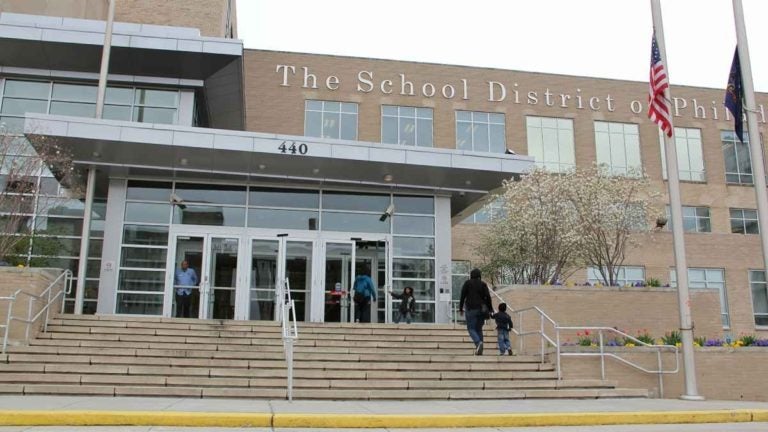
School District of Philadelphia. (Emma Lee/WHYY)
Outdoor activities are canceled at all Philadelphia public schools today as smoke from wildfires in Canada hovers over the city.
School district officials say they’re following local health experts’ lead. This morning, the city’s health department upgraded its air quality designation from code orange to a more serious code red.
“This means that students and staff should remain indoors and limit time outside,” district spokesperson Monique Braxton said in a statement. “Extended outside activities, such as outside field trips and field days should be postponed. Schools already on a field trip should move indoors. Recess and all outside activities should be moved indoors if possible or canceled.”
Outdoor athletics, including games, are also canceled and will be rescheduled.
Schools have been instructed to keep all windows and doors closed to “minimize air pollution,” something that could lead to uncomfortable conditions since most Philly public schools don’t have central air conditioning.
“Today’s forecast calls for a high of 79 °F. Though warm, the district does not expect indoor temperatures to exceed levels that would warrant early dismissal,” Braxton said.
The district enacted new heat protocols last year that instruct officials to monitor conditions when temperatures are projected to reach 85 degrees or higher and consider closing schools when they hit 90 degrees.
Ninety-one Philly schools closed early due to high temperatures last Friday.
District officials said they will provide updates if the air quality status changes throughout the week.
Masks have not been recommended or required by the district, though individual nurses at some schools have encouraged families to have their children mask up.
The last day of the school year for the students is June 13.
This dispatch originally appeared on NPR.
If you’re checking the forecast today and wondering how bad the air quality is in your area, you might have come across something called the air quality index, or AQI.
That’s the measurement scale the Environmental Protection Agency uses to judge how safe or hazardous the air is in a certain area.
The scale runs from zero to 500, with zero to 50 categorized as good air quality while anything over 300 is considered hazardous.
AQI is also color-coded, which makes it easier to understand the air quality conditions in your area:
- 0-50 is “good” air quality and colored GREEN
- 51-100 is “moderate” and YELLOW
- 101-150 is “unhealthy for certain groups” and ORANGE
- 151-200 is “unhealthy” and RED
- 201-300 is “very unhealthy” and PURPLE
- 301 and above is “hazardous” and MAROON
Extreme heat can cause air quality issues. See the chart below to understand what the AQI Index numbers & levels mean.
☑️Check on the current air quality in your area: https://t.co/V15BJucMd8
☑️Use @CDCgov‘s heat & health tracker to identify heat risks: https://t.co/XHWwhAFsiz pic.twitter.com/vv2pq7eo1s
— FEMA (@fema) July 12, 2022
Wildfire smoke contains particulate matter, which can be harmful to human health and is one of the pollutants that factors into the AQI.
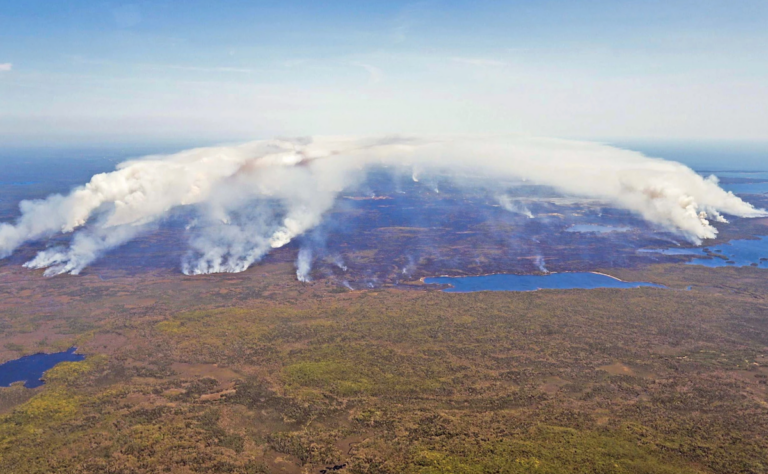
In this aerial image, wildfires burn in Shelburne County, Nova Scotia, last week. (Communications Nova Scotia/HO/AP)
This dispatch originally appeared on NPR.
So far this year, 2,214 wildfires have raged across Canada, according to Minister of Emergency Preparedness Bill Blair. The blazes have burned 3.3 million hectares — or more than 8 million acres.
The country is currently battling 413 wildfires, 249 of which are categorized as out of control, and an estimated 26,000 people remain evacuated from their homes.
Across Québec, more than 150 fires are raging, many of which are burning out of control, according to the province’s forest protection service. Authorities have restricted access to parts of the forest and closed some roads.
“This is a scary time for a lot of people, not just in Alberta, but right across the country, including in the Atlantic, the North and Québec, too,” Prime Minister Justin Trudeau said at a news conference on Monday.
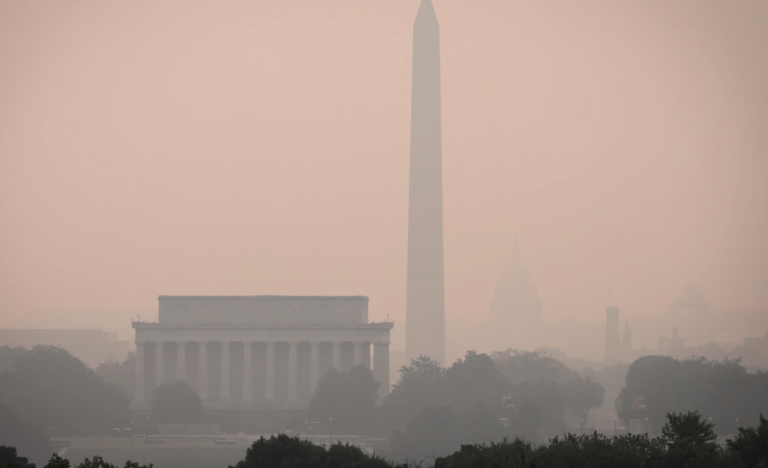
Hazy skies caused by Canadian wildfires blanket the monuments and skyline of Washington, D.C., on Wednesday. (Win McNamee/Getty Images)
This dispatch originally appeared on NPR.
How bad is the air quality where you and your loved ones live? How does your neighborhood compare to the rest of the country and even the world?
You can find those answers through AirNow, a comprehensive online resource compiled by federal, state and local agencies.
Check out its interactive map for a national overview of air quality conditions and warnings, and click on your area to learn more. You can also type your city, state or ZIP code into the search feature to pull up the latest guidance.
AirNow reports air quality using the official U.S. air quality index (AQI), the color-coded index spanning green to maroon. As of Wednesday morning, the site’s air quality map shows the Eastern half of the U.S. awash in yellow, orange, red and purple.
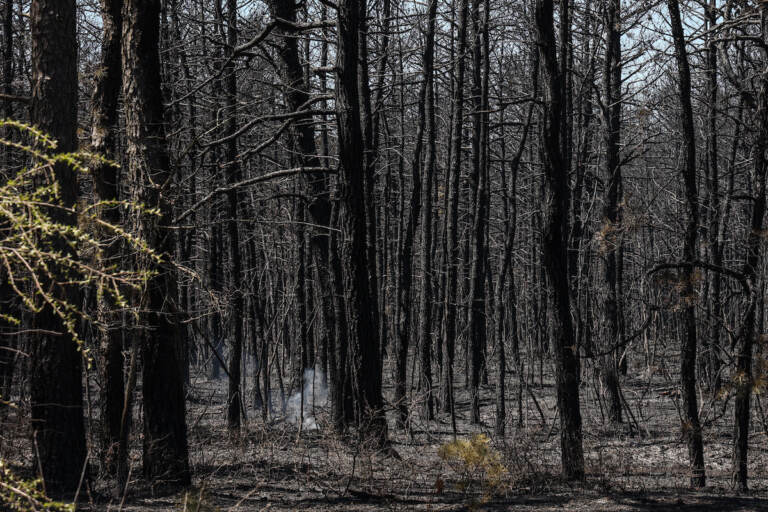
A wildfire left trees in the National Pine Barrens charred and smoking in Manchester Township, N.J., on April 12, 2023. (Kimberly Paynter/WHYY)
This dispatch originally appeared on NPR.
In the U.S., wildfire seasons are dragging out and burning more acres in recent years, thanks in part to climate change, experts say.
The Biden administration launched an effort earlier this year to combat what it called a “wildfire crisis” in the Western U.S., with Agriculture Secretary Tom Vilsack saying it’s “no longer a matter of if a wildfire will threaten many Western communities in these landscapes, it is a matter of when.”
But it’s not just this country — the United Nations warned last year that global warming and land use changes will lead to more wildfires across parts of the world, which could cause public health challenges and other problems.
The authorities battling Canada’s current wildfires say they expect an already destructive season to worsen over the coming summer months, too.
Jeff Schlegelmilch, director of the National Center for Disaster Preparedness at Columbia University, warns that people across the globe should take note, since populations worldwide could be dealing with the effects of wildfires more regularly in the years to come.
“This is something that I think even for folks who are not involved to kind of pay attention to, because this is the type of situation that we’re expecting that we’re going to see more of — not less of — into the future,” he told NPR this week.

An experimental smoke and haze forecast simulation from NWS Mount Holly (NWS/Twitter)
Smoke blanketing the Philadelphia region could diminish some through midday before thickening once again this afternoon and evening. That’s the prediction from the National Weather Service’s experimental smoke and haze forecast simulation.
The NWS map shows heavier smoke starting to move into the Philly area around 4 p.m. with the worst of it covering southeastern PA and much of South Jersey by 9 p.m.
Experimental smoke and haze forecast simulation: the smoke and haze is anticipated to have some improvement this morning, however an additional plume of thick smoke should spread south into the area later this afternoon and evening. Avoid time outdoors. #PAwx #NJwx #DEwx #MDwx pic.twitter.com/Qqn4z3qyqd
— NWS Mount Holly (@NWS_MountHolly) June 7, 2023
“There’s another wave of heavier smoke that is just moving into northwestern New Jersey now and spreading south, southeastward. I expect that things in much of New Jersey will get worse before they get better,” said Anthony Broccoli, an atmospheric scientist at the Rutgers School of Environmental and Biological Sciences. “This unusual situation results from a combination of wildfires in eastern Canada and a persistent weather pattern that is bringing the smoke from those fires south across our area.”
A separate smoke forecast map put together by the Weather Forecast Research Team at the University of British Columbia shows similar expectations for deteriorating conditions later Wednesday.
https://firesmoke.ca/forecasts/current/
The Canadian map offers details on the daily average and daily maximum concentrations of smoke particles at ground level from the wildfires.
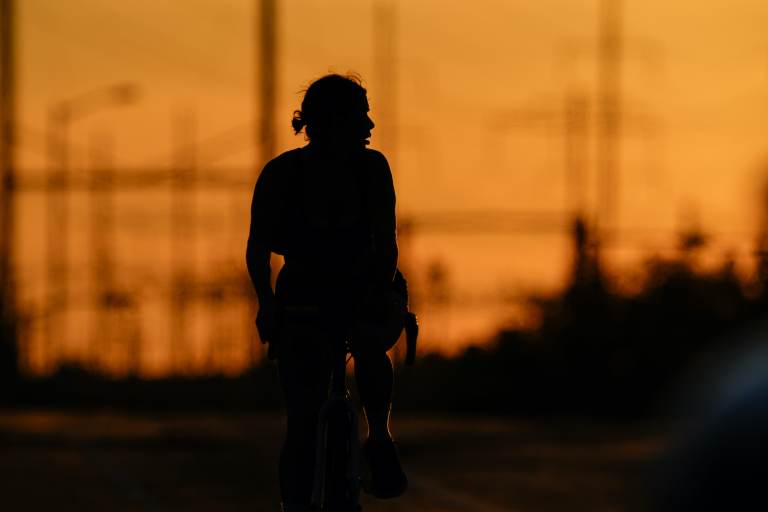
A cyclist rides in the day’s diminishing light, Wednesday, June 23, 2021, in Philadelphia. (AP Photo/Matt Rourke)
Health officials on Tuesday evening issued a warning to avoid going outdoors as much as possible.
Smoke is being funneled down from raging wildfires in Quebec due to “a unique weather pattern,” the Philadelphia Health Department said. It’s created a noticeable haze around the region which is dangerous because it’s made up of tiny particles that can go deep into your lungs when inhaled.
Philly’s air quality index on Wednesday morning was extremely high: with meters registering an AQI of 212, above red and into the purple range. For reference, 0 to 50 is considered “good” and anything above 200 is “very unhealthy. (You can check your area and stay up to date at airnow.gov.)
What should you do about this? Here are some recommendations from the Health Department.


